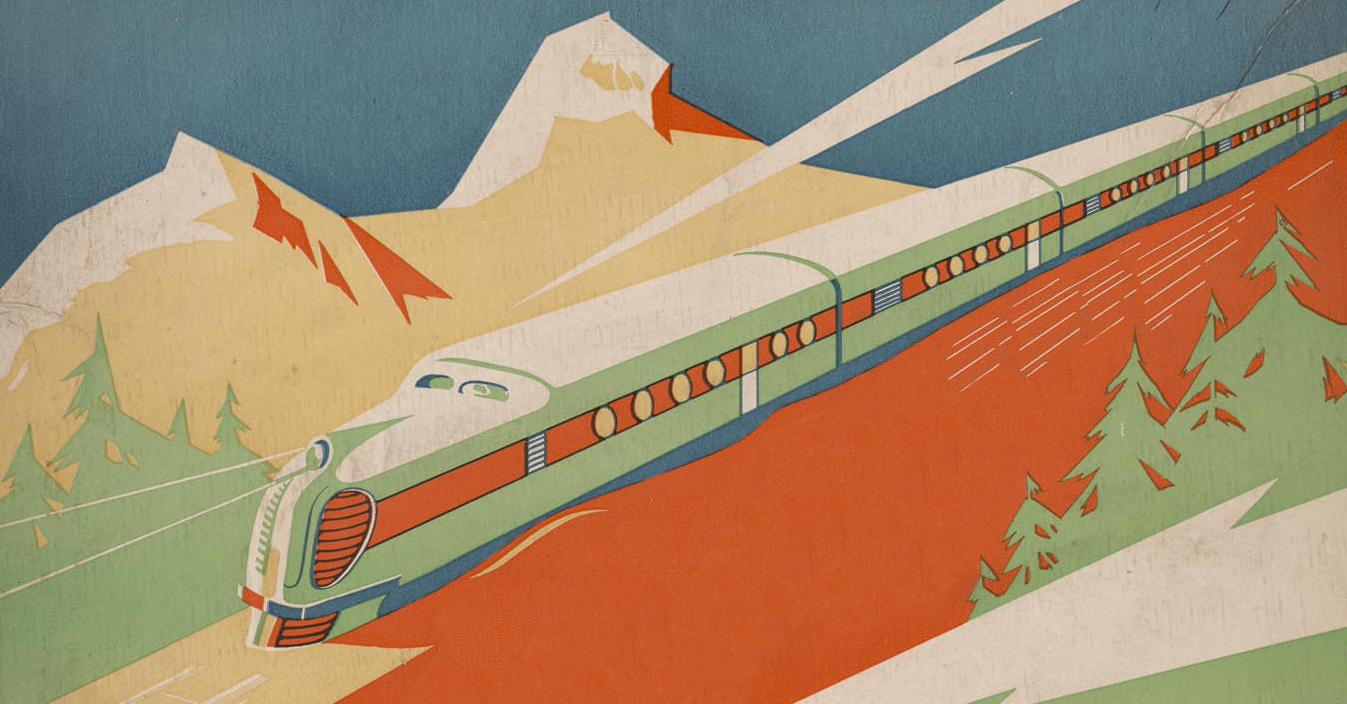

33. G.F. Morse, Del. & J.H. Buffords, Lith., Portland Company’s Passenger Engine, Portland Cos. Works, Portland, Maine, 1854.
On loan from the collections of Dr. Walter Goldfarb
The Portland Company was established on November 10, 1846, by John A. Poor and engineer Septimus Norris of Norris Locomotive Works in Portland, Maine. The company was established as a locomotive foundry and became one of the leading medium-to-heavy steel manufacturers in New England. Located on the waterfront in Portland’s East End, from 1848 to about 1978, the company produced over 600 steam locomotives as well as 160 merchant and naval vessels. These carefully and beautifully rendered lithographs of freight and passenger engines depict the elegant design and superior craftsmanship the company was known for.
34. Howell-North, Sandy River & Rangeley Lakes Railroad, 1959.
Bates Sheet Map Collection.
www.oshermaps.org/map/52600
The first railroads were built using a variety of track gauges (the distance between the rails), but, by the mid-1800s, American railroads settled on a standard gauge of 4 feet, 8 1/2 inches, which allowed locomotives and cars to move easily between lines. However, some railroad promoters in Maine argued for the much smaller gauge of 2 feet, which would permit cheaper construction in serving less populated areas. Maine’s first “two-footer” opened between Farmington and Phillips in 1879. This map was printed in 1959 as a book supplement to Linwood W. Moody’s Maine Two Footers and shows the group of connecting two-foot gauge railroads which merged in 1908 to form the 120-mile long Sandy River and Rangeley Lakes Railroad. In a development unique to Maine, several other two-foot gauge railroads were built elsewhere in the state. The inability to interchange freight cars with the standard gauge railroads eventually doomed the little lines. The last “two-footer” was abandoned in 1941. However, the quaint “two-footers” endeared themselves with railfans and local historians, and today, several museum groups in Maine carry tourists using preserved two-foot gauge locomotives and cars on newly laid two-foot gauge track.
35. Jordan and More Press, Bangor & Aroostook Railroad and Connections Including Northern Maine Hunting and Fishing Region, circa 1928.
Osher Map Library Sheet Map Collection.
www.oshermaps.org/map/2421
Northern Maine’s Aroostook County was the last frontier in the eastern United States. When the transcontinental railroad was completed in 1869, Aroostook County was sparsely populated and without any railroad. Beginning in the 1870s, Canadian railroads built short branches into Aroostook County to reach towns close to the Canadian border, but public sentiment increasingly demanded an American railroad to serve the county. To provide this connection, the Bangor & Aroostook Railroad was chartered in 1891. The Bangor & Aroostook acquired existing lines from the Old Town, near Bangor, to Greenville and Brownville. The new railroad built north through Houlton and Presque Isle, reaching the northern boundary of Maine at Van Buren in 1899. This map shows the fullest extent of the railroad with 630 miles of line in the 1920s. While hauling potatoes from Aroostook County was a speciality of the railroad, this map’s mention of hunting and fishing promoted the Bangor & Aroostook’s modest passenger service. When Great Northern Paper opened a large paper mill in Millinocket in 1900, the company became the line’s biggest shipper. After interstate highway construction in the 1960s and 1970s, potato traffic shifted to trucks. Today, surviving portions of the Bangor & Aroostook railroad are operated by some short line railroads.
36a. Pullman Company, [Image of Pullman car], 1890.
Osher Map Library Ephemera Collection.
www.oshermaps.org/map/44778
36b. Lansing’s Ticket Office, Railway and Steamboat Tickets.
Osher Map Library Ephemera Collection.
www.oshermaps.org/map/45108
36c. Model train set up.
Courtesy of Mark Matteau
While the advent of railroads was transformative to the industry and expansion of the United States in the nineteenth century, many essential innovations came out of Britain. Richard Trevithick, a British inventor, designed and created the world’s first steam powered locomotive in 1804. In 1814 George Stephenson constructed the first steam engine that could outrun a horse while pulling a load. He continued his work and established the first steam powered railroad in 1825, the Stockton and Darlington Railway. This railroad stretched only 12 miles, or 19 kilometers, but was the first freight line in Britain. Stephenson can be credited with a number of important contributions to railroading, including the introduction of a standard gauge (the spacing between the rails on a railroad track) of 4 feet 8 ½ inches or 1.44 meters. Perhaps most importantly, he built the Liverpool and Manchester Railway. The Liverpool and Manchester Railway began service in 1830 as the first steam powered railway in the world to offer regular passenger service. By the 1840’s a virtually complete rail network connected the vast majority of cities, towns and villages in Great Britain.
During the late nineteenth and early twentieth centuries most of the early rail lines were amalgamated or brought under control by a few larger companies. By 1923 all British rail companies were grouped into “The Big Four,” the Great Western, the London and North Eastern, the Midlands and Scottish, and the Southern, which, represented the various regions served. These separate lines continued to operate until the 1947 nationalization under the name of British Rail.
In this case, Mark Matteau has set up various British model trains as an example of changes and innovations in passenger and freight service.